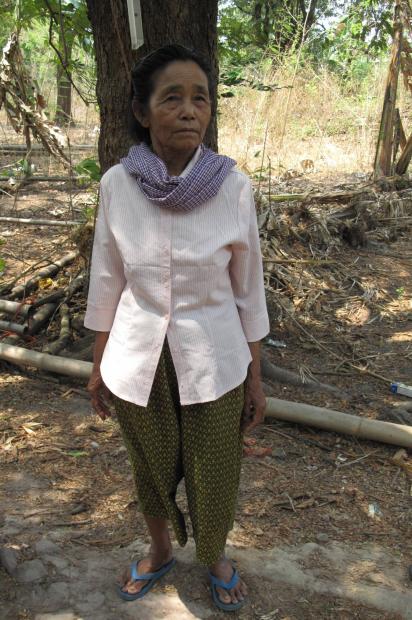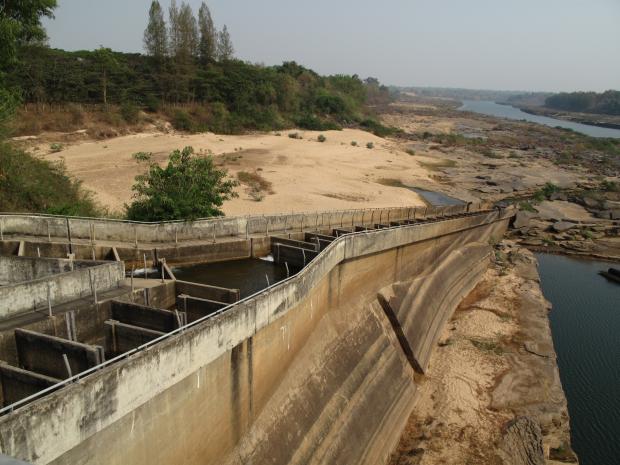(蒙河口大坝)
美国、日本、亚行和世行支持的湄公河开发计划至少可追溯到上世纪五十年代,日本在该流域进行的水电开发甚至始于二战前。
据Toshi介绍,美国介入湄公河筑坝和水电开发的背景是冷战,而日本的动机则来自两个方面,一是二战后国内筑坝技术的积累,二是日本对其它亚洲国家以对外援助和官方发展援助(ODA)给予的战争赔款。一些日本私营筑坝公司将目光投向了前景无限的海外市场,将自身业务与战争赔款结合起来。另外,东南亚国家若想尽快步入快速发展轨道,充足的电力当然不可或缺。因此,世行和亚行也推动了许多筑坝项目。
资料所限,作者无法详述将湄公河筑坝和水电开发的历史情况,因此将湄公观察负责人Toshi的简要介绍后附,有兴趣的读者请自行参考。
美国田纳西河大坝在历史上曾被认为是巨大的“成功”,因大坝可以带来就业,和清洁、廉价、可持续的能源。但美国国内很早就对此进行了一些反思,包括著名的环保案件——田纳西流域管理局诉希尔案。
上世纪70年代,日本国内的造坝运动渐趋尾声。目前,日本大小河流约有3000多座水坝。
宁静的村庄无法抗拒发展的洪流,人们的生活发生了或大或小的改变。村民们和NGO认为,一切祸端始于坝。
湄公河及支流上共有多少座大坝,尚没有准确的统计。根据International Center for Environmental Management组织2010年的报告,到2030年,湄公河支流预计有71座大坝进行运营。
“一年中时令不同,鱼的种类也不同,我们把河流叫做fish ATM,来形容物产之丰富。捕不同的鱼要用不同的器具。以前,孩子从四年级开始就要学习制造渔具。”泰国蒙河口大坝边的一位村民自豪地说。
如今这些渔具已变成他们陈列馆中的展品,连同以往捕获大鱼的骨骼。蒙河口大坝建于1994年,约3000户村民,两万多人被迫搬迁。村民的抗议持续了20年,直到现在。
(陈列馆里展示的部分渔具)
“每年四月,许多鱼都要回游到这条河。大坝建成之后,一切都消失了,河中丰盛的物种,连同我们美好的传统。”村民说。
泰国乌汶府的村民说,蒙河口大坝(Pak Mun Dam,Pak泰语意为口,指该大坝建在湄公河与大支流蒙河交汇处)和诗琳通大坝(Sirindhorn Dam,该坝初期以河流命名,后随泰国公主诗琳通更名)令他们丧失了生活来源,陷于贫困。
据统计,在大坝建成前,蒙河中的鱼类共有250多种,而建成之后,这个数字锐减到90多种。
在蒙河居民抗议之后,泰国首相下令开闸一年,看鱼的种类是否有所恢复——确实,鱼类又增加到150多种。但第二年,开闸的时间被缩短到每年四个月,有时甚至四个月也不能保证。
政府为了保存鱼类的多样性,起先建了鱼梯(fish ladder),但事实证明,蒙河的鱼儿无力沿鱼梯上溯回游,于是政府又宣布改建一个鱼升降机(fish elevator)来安抚民众。
(鱼梯,减少坡度。需要回游、却无力“跳龙门”的鱼类可以像爬梯子一样“拾级而上”。但蒙河里的鱼类体型较小,这座鱼梯的建设没有成功帮助它们完成回游。)
湄公观察的Yuka说,蒙河口大坝是湄公河大坝的一个典型案例。这座大坝实际所发电力远小于初期设计,其实只够支持曼谷的三四家百货商店,不幸的是,这也是泰国许多大坝的的真实状态。
虽然产生的电力对国际大都市曼谷来说几乎是九牛一毛,但一座大坝往往牵涉到数千户当地居民的动迁。以蒙河口大坝为例,大约有6170户村民的生活受到了影响。
得到电力的方式有许多种,政府为何要选择水坝?简单说来,利用自然之力的水电成本更低,但这种计算显然没有考虑更复杂的成本——村民生活的可持续性及生物多样性。
许多研究表明,建筑这座大坝的综合社会成本比发电收益要高得多,但Yuka说,泰国政府仍然不肯妥协,也许是担心给全国带来的示范效应。
大坝建成后,村里已没有足够的生计,很多村民被迫去曼谷以捡垃圾为生。一位老妇人对我们说,直到去曼谷捡垃圾,她才第一次看到五光十色的都市生活,并为那里巨大电力的浪费感到震惊——曼谷的商场在炎炎夏日里将空调开足马力,却根本——不关大门。
见识到以毁灭村庄为代价贡献的电力是如何被挥霍之后,村民们更感到自己的牺牲完全不值得。他们认为,与其毁灭更多村民的生活去供养都市的需求,工厂、百货商店,那些自私的都市人也许更应该好好反思如何节电。
“我们不需要电,工厂、百货商店才需要,我们为什么要为曼谷的陌生人牺牲?”他们说。“希望我们的故事被广泛地传播,这样政府在做类似事情时,就会了解村民们会如何反应。”
失败的补偿
说东南亚政府完全不考虑村民的生活,也并不公平。泰国政府确实对受影响村民的土地和房屋给予了赔偿,还建设了一些安置房。
村民们的想法很实际:赔偿至多只能支持一代人的生活,他们要的是可以持续的生计。一个村民说,钱是幻影,鱼米才是实在的和永远的。我们不求赔偿,只求开闸。
“河流提供了如此多的食物,伸手可得。我们不需要政府做什么,只需开闸让水自流。我们以前根本就不需要用到钱,现在要靠汽车市场开到村里,才能用钱去换得生活必须的食物。生活更差了,家庭分散,孩子们去曼谷和其它大城市寻找机会,很少机会见面。”
(有些村民做起了家具加工生意,但这种从农业转向商业的机会在当地少之又少。)
诗琳通水库的村民们说,他们有时因没钱购买食物而向银行借贷,年息为6%。为购买食物而非再生产所借的债务,只会越累越多,直至无力偿还。
谁能料想,年轻时生活无忧无虑,老来却为一口吃的而负债?一位老妇人绝望地说。
泰国政府也采取了一些举措,希望帮助村民完成转型,比如提供新的可耕种土地,或通过合作社提供贷款,提供技能培训课程,鼓励他们创立小生意,重新就业。
但村民对赔偿的金额以及安置房的配套普遍表示不满,他们说,总的来看,生活是比以前更差了。补偿的土地往往是未开垦的林地或沙地,政府不提供清理,而且没有配套灌溉设施。
极少有村民向合作社申请过贷款,技能培训课程也对村民们缺乏吸引力,看上去很美好的解决方案完全落空。更多失地村民走向了建筑工地,有一搭没一搭地打着零工。
“政府提供过理发的培训,可谁会来村里理发?”当地村民说,对他们而言,改变生存方式并不像政府设想的那么容易。“我们没有经验,没有知识,无法去做新的工作。更糟的是,本土的智慧也消失了,那些打渔的智慧和乡里之情,没有下一代传承。”
大坝不仅意味着家庭收支表的变化,还意味着东南亚乡村社会结构的变化,而人们对此并不习惯。
“如果他们想在别处建坝,请千万阻止他们。大坝建成以后,村民的生活如此艰难,过去人们有了多余的渔获,会乐意与村邻们分享。现在有了多余的产品,不会再分给邻居,要自己卖掉赚钱,因为每个人都需要用钱,浇灌田地需要水泵,要用钱去买电。”诗琳通大坝的一位老妇人说。

(村里一位70岁的老妇人指给我们看被大坝淹没的旧居。她曾是一个渔民,为反对修坝到首相办公室请愿,到爆破现场抗议——请愿前,甚至没有任何人通知村民哪些地区将被淹没。“之前一直住在村里,从没看过外面的世界,本来和官员说话都会紧张”。虽然请愿最终没能成功阻止大坝的建设,但政府公布了水库的范围并提供了赔偿。政府后来收购了被淹没的土地,但她却执意不卖,至今仍持有被淹没地块的产证,以留作纪念)
Toshi的介绍
湄公河水电开发的部分历史:
The following article may be used as a reference:
Akita, Satoru. 2010. “Evolution and Demise of the Tennessee Valley Authority Style Regional Development. Scheme in the Lower MekongRiver Basin, 1951 to the 1990s: The First Asian Initiative to Pursue an Opportunity for Economic Integration”:
As for Japan, its involvement with Mekong dams came about from two directions. One, Japan’s accumulated technologies on dam building before and during the WWII had to be exploited for its post-war reconstruction and economic growth. One person in particular, Mr. Yutaka Kubota, was instrumental in this. The following is an excerpt from his company’s (Nippon Kohei, which is the leading Japanese consulting company) description of its history and Kubota’s achievements. Keep in mind that the description is a bit glorified:http://www.n-
Japan also had to give war reparations to Asian countries, including China. It was decided that Japan would give its war reparations in the form of foreign aids, or official development assistance (ODA). This was the second direction. The following article explains this part of Japan’s history:
Furuoka, Fumitaka, Mikio Oishi, and Iwao Kato. 2010. “From Aid Recipient to Aid Donor: Tracing the Historical Transformation of Japan's Foreign Aid Policy”:
Read especially the following three paragraphs under “3.1. Features and Issues of the Pre-Donor Period Two” (copied below for your convenience):
“Another specific trait of this period is that the inclusion of the private sector into Japan's ODA program took place during the 1950s. Since then, the private sector has been playing a key role in forming Japan's aid policy. The views of and policy recommendations from corporate figures were voiced through official advisory councils and were incorporated into Japan's ODA programs. As Arase (1994: 174) observed, 'The Baisho Jisshi Kondankai (Reparation Implementation Deliberation Council) was created by the Foreign Ministry in 1954 to give private sector leaders a hand in shaping the policy'. In some cases, Japanese firms were even able to influence the government's decision as to where the reparation payments would be channelled. For example, an engineering consultant, Yutaka Kubota, persuaded the Japanese government to include physical capital investment projects, such as dam construction, as part of reparations payments (Sumi 1990: 130-33).
“According to Sumi (1990), Kubota had built several dams in Asian countries before he lost his business after Japan's defeat in World War Two. In the beginning of the 1950s, Kubota visited Burma and found a potential dam site there. In 1953, when the negotiations on the reparations payment between Japan and Burma were in progress, he pressed the government to include the construction of a dam into the discussions. At first, the government refused to consider his proposal. Then, Kubota appealed directly to Prime Minister Shigeru Yoshida and persuaded him that the project would benefit Japanese companies. After Prime Minister Yoshida's intervention the Japanese government included the construction of a dam as a part of reparation payment to Burma (Sumi, 1990).
“Japan's reparations payment agreements included similar projects in other Asian countries, such as Indonesia, Laos, and Vietnam (Sumi, 1990). As Sumi notes, this pattern of including big infrastructure projects to be implemented by Japanese companies as a part of economic assistance, which had originated during the time of reparations payments, became a prototype for Japan's ODA policy. According to this model, as a first step, consultants are engaged to identify a project that would be viable to be implemented under Japan's ODA program; then pressure is put on the government to include the project as part of the aid program; finally, Japanese companies are appointed to carry out the project's implementation.”
What it says in short is that Kubota (and his followers) used his technological knowledge and political power to successfully link Japanese public money (development assistance) to back up Japanese private companies’ (including his own company) business to build dams in Mekong (and some other countries). The development assistance was given under the name of war reparations, which sounds like benefitting war-affected people in Asia, but in fact helped the Japanese dam industry find jobs and sign contracts and some political leaders in recipient countries save a lot of cash in their bank accounts.
湄公河主干流大坝的数量:
I am not sure how many dams have been built all together in all the Mekong countries. The number also depends how you count, only dams in operation or planned projects included. If you are trying to give descriptions on Mekong’s dam rush, the following figures may be indicative.
First, you can find a sentence “Most Mekong River tributaries have cascades of dams in place or planned with some 71 projects expected to be operational by 2030” in the summary section of the following document:
International Centre for Environmental Management. 2010. STRATEGIC ENVIRONMENTAL ASSESSMENT OF HYDROPOWER ON THE MEKONG MAINSTREAM: FINAL REPORT
In the same document on page 15, you can see a map on which eight dams are built/planned on the Lancang section and 11 (or 12 because some count Don Sahong and Thakho as two rather than one) on Lower Mekong. That’s 19 in total on the mainstream Mekong.
Laos is definitely the country in which many of the Mekong dams are being build/planned. The following is Lao government’s official document made in 2012:
According this document, the number of dams in Laos at various stages are as follows:
Operational: 15
Under construction: 11 (The 1st one is not a hydro. It’s a lignite coal-fired power plant.)
Planning (PDA=Project Development Agreement stage): 25
Planning (MOU stage): 35
This give us 86 dams (built and planed all together) in Laos alone.
0
推荐










 京公网安备 11010502034662号
京公网安备 11010502034662号 